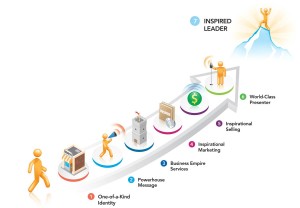By now, and especially after the PDF I sent out recently, you know that you need a progressive line-up of programs with a low-time/low- investment “front end” that builds to a more-time/higher-investment “back end.” And you’ve heard the rule that “the profit’s in the back-end, ” which is true. You invest in customers at the front-end, but don’t need to continue getting new customers because they flow naturally into the back-end.
investment “front end” that builds to a more-time/higher-investment “back end.” And you’ve heard the rule that “the profit’s in the back-end, ” which is true. You invest in customers at the front-end, but don’t need to continue getting new customers because they flow naturally into the back-end.
So, how do you develop this “ladder” of programs? (I call it the FE-BE ladder.)
Well, as Steven Covey is famous for saying, “You start with the end in mind.”
What is the end result your customer wants? (If you’re this far in strategic planning, I presume you have the foundation set: you know your market, their greatest pain, what they’d kill to have, and your #1 solution.)
In my case, the experts I serve want a formidable, marketable, one-of-a-kind Inspired Leader business–ready-to-go, ready to change lives, ready to make money—fast and sans all the pitfalls.
So, what is the final result your customers want?
Next, you want to write down all of the typical mistakes they make on their way to that desired result. Perhaps their final result is to be in a loving, long-term relationship–but your male customers tend to be too ego-centric, too career-focused, date too many women at one time, stay distant so as not to be too emotionally intimate–and on and on.
This list now magically reveals the skills they need to learn/actions they need to take.
 You write out that list, from start to completion: what they must learn first, second, third…thirty-fourth…fifty-sixth…until you’ve exhausted everything it will take for them to get to their desired result.
You write out that list, from start to completion: what they must learn first, second, third…thirty-fourth…fifty-sixth…until you’ve exhausted everything it will take for them to get to their desired result.
This is a good time to discuss an exception: I didn’t write my list of mistakes my market makes because frankly it’s so numerous, it would take up three paragraphs, but I will use myself as an example now to show you that you may not be teaching skills–as I don’t anymore. I get my clients their “entire business ready-to-make-money” by rolling up my sleeves and doing it with/for them. So, in this case, there are projects they must complete, not so much skills they must learn. If that’s the case for you, then you would write out everything that must be done to arrive at the final destination for your customer.
Now, you have a long list of skills they must learn/projects they must complete. This list becomes your FE-BE ladder! You break those skills/ projects into consumable chunks…i.e. programs. Your first set of skills will be the most-needed, “hot-button skills,” and will comprise your Signature Program.
The next set of needed skills becomes the next-in-the-line-up program. Voila! Easy-peasy. (Well, sort of.)
This is the mistake MOST experts make: Their programs are not progressive. They’re, at worst, a hodge-podge mess of disparate ideas–and at best, good concepts, worthy of a program–but that don’t bridge from the last program.
Why do you want them to bridge? So you don’t have to go out and get new clients! So, the person in Program A moves naturally to Program B, then on to Program C, etc. And you want them to feel compelled to go to the next program because it has the next-in-line skills they know they need to arrive at their desired destination.
My clients never want to leave my progression, because they know they need every project in my line-up: their one-of-a-kind brand identity and Inspired Thought Leader message…(that’s one consumable chunk, The Powerhouse Method(TM))…then they need to express that in tangible forms: develop their free product, paid product, Portal (free feeder) Program and Signature Program (the next consumable chunk)…then they need a full marketing strategy and the marketing copy, so those tangible items convert (the next consumable chunk), they need all of that tested and evaluated by me (the next consumable chunk) and finally, to deliver it all with dynamic power, they need to learn my system for being one of the most effective speakers/teachers in the world (next consumable chunk.)
In a successful business funnel, each program starts where the last one left off. This is how your Front-End/Back-End ladder should look…and I just gave you a super-fast way to create it. So, don’t waste a minute: go develop yours right now!
 On April 16, you’re going to get the chance to evaluate ALL of your funnels: business, marketing and sales on the first-ever “Game-inar:” BizLibs: Funnel Vision. Remember MadLibs? It’s like that: you’re filling in blanks in a fast-paced, timed environment that will squeeze great ideas out of you and show you what you need to improve. You’ll walk out with a KILLER blueprint for exactly what you need to do to integrate your funnels. Just as our endocrine, circulatory, and nervous systems are us, your funnels are your business—and can either be sick or healthy. We’ll get them healthy on this very special webinar. Click here to read more and register!
On April 16, you’re going to get the chance to evaluate ALL of your funnels: business, marketing and sales on the first-ever “Game-inar:” BizLibs: Funnel Vision. Remember MadLibs? It’s like that: you’re filling in blanks in a fast-paced, timed environment that will squeeze great ideas out of you and show you what you need to improve. You’ll walk out with a KILLER blueprint for exactly what you need to do to integrate your funnels. Just as our endocrine, circulatory, and nervous systems are us, your funnels are your business—and can either be sick or healthy. We’ll get them healthy on this very special webinar. Click here to read more and register!





 I am also pleased to see that they have a target market!
I am also pleased to see that they have a target market!